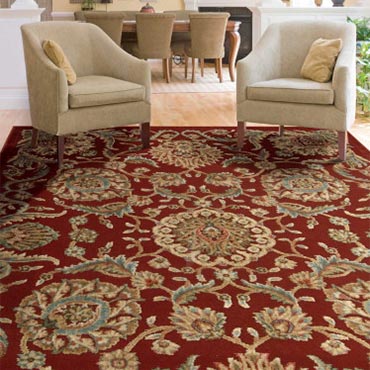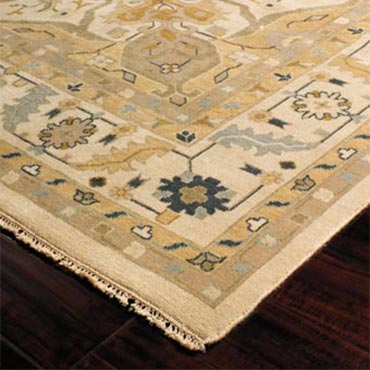Kathy Ireland's rugs are beautiful, durable, machine-crafted of plush 100% polypropylene in a Wilton woven construction inspired by her travels all over the world. Learn More


 Open almost any decorating magazine and you will find Oriental rugs shown as being an integral part of home decor. Oriental rugs are eclectic and fuse superbly with contemporary, formal, ornate, casual and traditional decorating styles. Oriental rugs are as adaptable to the casual living styles of today as they are to a formal corporate boardroom.
Open almost any decorating magazine and you will find Oriental rugs shown as being an integral part of home decor. Oriental rugs are eclectic and fuse superbly with contemporary, formal, ornate, casual and traditional decorating styles. Oriental rugs are as adaptable to the casual living styles of today as they are to a formal corporate boardroom.
Oriental rugs are thick and rich, high in art content, often in multi-colored patterns or featuring representational designs. The typical color range for an oriental rug includes black, soft yellow, pastel pink, peach, apricot and blue.
Originally oriental rugs were hand-woven in China. Today, machine-made oriental rugs designs are made in virtually in every country. The warmth and beauty of Oriental rugs can bring interest and luxury into almost every room of the home. Their amazingly resilient and durable qualities make oriental rugs perfectly suited for heavily trafficked areas as well as seldom-used guest rooms.
Authentic Oriental rugs are either knotted with pile or woven without pile by hand. Oriental rugs made by machine or any method other than hand knotting or hand weaving are not considered authentic oriental rugs.
Authentic handmade Oriental rugs normally come from a broad geographical region extending from China and Vietnam in the east to Turkey and Iran in the west and the Caucasus in the north to India in the south. People from different cultures, countries, racial groups and religious faiths are involved in the production of oriental rugs.
Oriental rugs are generally organized by origin: Persian rugs, Anatolian rugs, Kurdish rugs, Caucasian rugs, Central Asian rugs, Chinese rugs, East Turkestan rugs and Tibetan rugs.
When we think of Persian rugs, we usually think of intricate curvilinear designs; however, there are over fifty different Persian styles woven in Iran and other countries around the world.
Caucasian rugs are woven by tribal weavers of the region south of Russia, near the Caucasus Mountains, between the Black and Caspian Seas. One common characteristic among Caucasian rugs is the positioning of similar shapes in different sizes next to one another. Another common characteristic is their colorful and bright palette.
Anatolian (Turkish) rugs generally come in smaller sizes. The majority of Anatolian rugs are prayer rugs with very distinct designs. Anatolian runners are also common. Most Anatolian rugs seem to be geometric and very much influenced by Caucasian designs.
Turkoman rugs are produced by nomadic weavers of Turkmenistan, Uzbekistan, Afghanistan and the province of Khorassan in northeast Iran. Turkoman rugs are easily distinguished by their three characteristics of a dominant red to red-brown background color, geometric pattern, and a unique octagonal motif known as gul, which has several versions.
The area in western China above Tibet was called East Turkestan. Even though the area itself is no longer called East Turkestan, the rugs of this area are still labeled as East Turkestan rugs. The layout of East Turkestan rugs can be either medallion or all-over. Their pattern is mainly geometric. East Turkestan rugs tend to be long and narrow. A very common design is the pomegranate and vase, which is a symbol of fertility.
Tibetan rug making is an ancient art and craft in the tradition of Tibetan people. These rugs are primarily made from Tibetan highland sheep's virgin wool. The Tibetan uses rugs for almost any domestic use from flooring to wall hanging to horse saddles.
Disclaimer: The information provided in this article is for general informational purposes only. While we strive to ensure the accuracy and reliability of the information presented, we make no warranties, express or implied, about the completeness, accuracy, reliability, suitability, or availability with respect to the content. Any reliance you place on such information is strictly at your own risk. We recommend consulting with professionals for specific advice tailored to your project’s needs, particularly regarding building codes, regulations, and product specifications.
Under no circumstances shall we be liable for any loss or damage, including without limitation, indirect or consequential loss or damage, arising from the use of, or reliance on, the information provided in this article.

The centuries-old Chinese textile industry is rich in history. While most antique carpets are classified according to a specific region or manufactory, scholars attribute the age of any specific Chinese rug to the ruling emperor of the time.
Learn More




